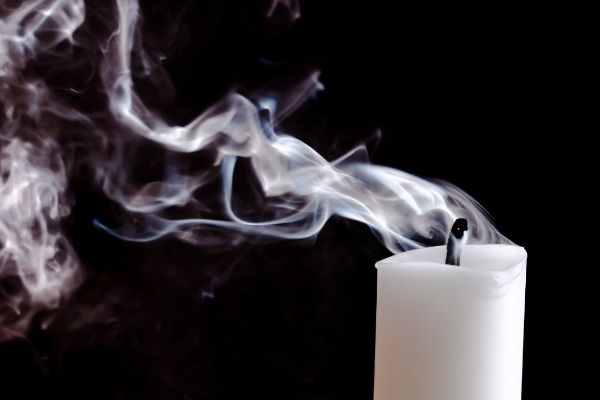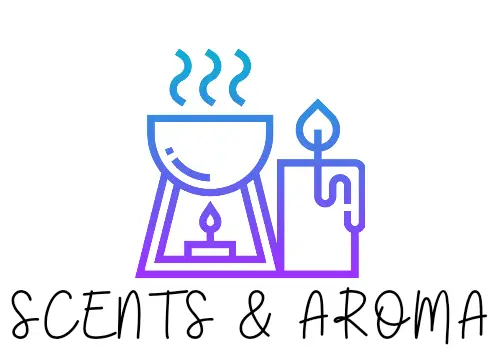Candles are one versatile product that are used for different purposes like as a light source, holiday decorations, creating romantic atmospheres, fragrance, etc. The harmful chemicals produced by burning candles are not enough to cause lung problems if used correctly and sparingly.
However, in the long run, it could be harmful to your health, particularly your lungs.
This article will provide answers to questions like;
- Do candle fumes damage the lungs?
- Are some candle waxes worse for the lungs than others?
- Does burning candles affect people with asthma or chronic lung illness?
- Safety tips when burning candles.

DO CANDLE FUMES DAMAGE THE LUNGS
Candles release soot that contains Volatile Organic Compounds (VOCs) and particulate matter which is known to be toxic and can damage the lungs. However, research has shown that the amount of these dangerous substances produced when burning candles is not enough to have any significant effect on health.
It is however possible that extended exposure to candle fumes will affect one’s lungs, causing lung problems. So you should avoid constantly burning candles every day. It is wiser to use them on special occasions. Avoid burning them in rooms with poor ventilation.
Also, scented candles that use unnatural fragrances instead of essential oil can be harmful to the lungs. Such candles produce more dangerous chemicals which could damage the lung. Scented candles that are made of paraffin wax are the most worrisome as the combination could be a health disaster.
ARE SOME CANDLE WAXES WORSE FOR YOUR LUNGS?
Yes, some types of candle wax have higher chances of damaging your lungs. This is because some of them are made of petroleum products and these kinds are the commonest because they are cheaper. For example Yankee Candles, one of the most popular are made from paraffin which is a known carcinogen However, candles that use vegetable-based waxes are safer and healthier, plus, they burn slower.
At the top of this list are candles that contain lead which can cause lead poisoning. It is safer to avoid candles with metallic cores as most of them contain lead. To test for lead content, pull the candle apart and rub the metallic core on white paper. If it leaves behind gray traces, then it contains lead. Lead candles are not health-friendly.
Another candle wax that is tagged high risk is paraffin wax. Candles made of paraffin wax produce more soot than natural ones. This means that your chances of getting lung problems are higher when using paraffin candles.
Paraffin wax is composed of carbon and hydrogen though the carbon atom composition will vary depending on the origin of the wax. It is known to produce petro carbons such as toluene and benzene as it is a waste product of petroleum. These chemicals are similar to the ones produced by car exhausts which are harmful to health. The VOCs and particulate matter released by paraffin waxes are said to be more than in other waxes.
Gel wax is quite similar to paraffin wax because they are both petroleum products. Gel wax is a petroleum-based wax or synthetic hydrocarbon and has a high composition of harmful chemicals. Although they are very attractive because of their transparent look, they could harm the lungs.
Candles made of natural waxes are said to be safer because they produce less soot than paraffin wax. Not only do they produce less soot, but they also release the lowest amount of dangerous chemicals. Such natural waxes include coconut wax, palm wax, beeswax, soy wax, and candelilla wax. For more information about the different types of waxes have a look at my helpful guide.
Most of them are made from plant products so they burn healthier and are more lung friendly. When going for a healthier choice, pick a candle that is made from a hundred percent natural wax.
NOTE: No candle is soot-free so do not buy into such marketin tell tales. All candles release soot, but some produce less than others. You can learn which candle wax produces the least soot by reading this guide that I wrote.
DOES BURNING CANDLES AFFECT PEOPLE WITH ASTHMA OR CHRONIC LUNG ILLNESS?
People suffering from asthma, other lung-related problems, and chronic lung illnesses already have congested airways and react to strong smells. So, burning candles does no good to their health.
The soot will irritate their lungs and do more damage to their lung conditions. These candles do not burn enough to destroy the harmful molecules they produce, so these chemicals are released and when inhaled by people with lung conditions, it does more damage to their lungs. People suffering from asthma could also get attacks as a result.
Unfortunately, the effect of candle fumes doubles for such people and so it is best that they steer clear of environments where candles are burnt.
If there is a need to burn candles, do not buy scented candles that use unnatural scents. Avoid paraffin wax candles and also, do not burn candles in tight areas like a small room, bathroom, or an unventilated one.
LUNG SAFETY TIPS WHEN BURNING CANDLES
To reduce the possibility of endangering your lungs, there are some safety measures you need to follow when burning candles.
- Trim the wick to be ¼ inch so the flame does not become too large.
- Follow the instructions on how long you should burn the candle. Usually, the burning length should not exceed four hours.
- Burn candles in a well-ventilated area so the soot can quickly disperse. Also, make sure the room allows for proper air circulation.
- Do not use your mouth to blow off candles. Instead, use a candle snuffer to snuff it out or use a wick dipper to dip the wick in the wax.
- Buy candles that use natural wax products like beeswax, and palm wax, instead of paraffin wax or those that have metallic cores.
- Avoid scented candles that use unnatural fragrances as their aroma source.
- Make sure the wax is burning down evenly along with the wick because uneven burning can lead to substandard burning.
- Do not go for candles with thick wicks, especially those with metal cores because they could contain lead.
- Avoid multiple wick candles. Although they may look very aesthetical, their wicks burn unevenly.
- Try not to burn too many candles in one room as this can congest the room with fumes hence, you end up inhaling more dangerous chemicals.
CONCLUSION
Burning candles does not produce enough dangerous chemicals to damage the lungs. Although such chemicals cannot really be completely avoided as they are present in the air because of many industrial activities, and the burning of fuels, we can however reduce our intake of them by burning candles the right and safe way.
There should be occasional use of candles, especially scented candles rather than making it the status quo. Also, when choosing candles, go for the ones that are more lung-friendly such as soy wax or beeswax.
- Can You Put Perfume In A Humidifier? (Read First) - September 17, 2022
- Can You Put Essential Oil In A Steam Mop? (Safety Advice) - September 17, 2022
- How To Make Lavender Oil At Home ( Candles And Diffusers) - September 9, 2022
